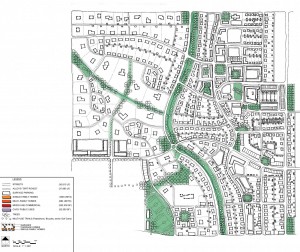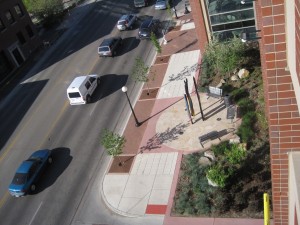
Landscape Urbanism sounds like a great name that really meshes together a lot of what I believe in and do as a professional. Landscape Urbanism is rapidly growing in popularity and I suspect this will continue as the CNU (Congress for the New Urbanism) is now getting involved. Not surprisingly, the “landscape urbanists” have a lot of the same beliefs that I have. There is one issue with the name that does bother me, and that is with the definition and core belief of landscape urbanists. According to Wikipedia: Landscape Urbanism is a “theory of urbanism arguing that landscape, rather than architecture, is more capable of organizing the city and enhancing the urban experience“. Although I feel that landscape and the work of landscape architects is critical in creating great places, there is no substitute for great urbanity defined by great architecture for “enhancing the urban experience“. I do feel that the definition is very accurate where it states that landscape, but perhaps more importantly, ecology, is very logical as an organizing element of the City. When organizing a city, or even a large neighborhood, the natural ecological factors of the site are critical. Every city and site are different and what may seem like limiting factors are crucial for a great neighborhood. To simply ignore the natural drainage patterns and topography of a site, or its wetlands and tree massings are a horrible mistake that is often made.

There are instances that I have come across where the building, due to its initial intended use, does not allow some of the features of architecture to frame the street and provide vitality. I believe that there is no greater substitute than great building frontage, which includes a lot of fenestration (glass/openings) and activity. When the use of the structure does not permit or desire openings along the streetscape, the landscape really needed to define the pedestrian experience. I like to propose several xeriscape plants, vines, etc. to soften the pedestrian experience and provide a sense of enclosure and interest. Utilizing a rhythm of plant material to help invoke the rhythm that a building creates, based on the columns of the building, can accomplish the desired experience. Using a lot of the principles of architecture, such as emphasizing nodes, can create place-making and pedestrian experience.
In summary, I do not feel that landscape is a substitute for good quality architecture in enhancing the urban experience, however, it is a tremendous companion. Landscape and ecological factors are critical in organizing cities. As Landscape Urbanism continues to evolve, I hope that it is embraced by New Urbanism and the New Urbanist community as a compliment to new urbanism. The two movements need to work together in enhancing landscape urbanism. Landscape Architects play a critical role in organizing our cities.
For those of you attending CNU Atlanta this next week, Andres Duany will be speaking about landscape urbanism the day before at a SmartCode Central presentation. The following is a link for registering for the SmartCode Intensive where Andres will be presenting.





